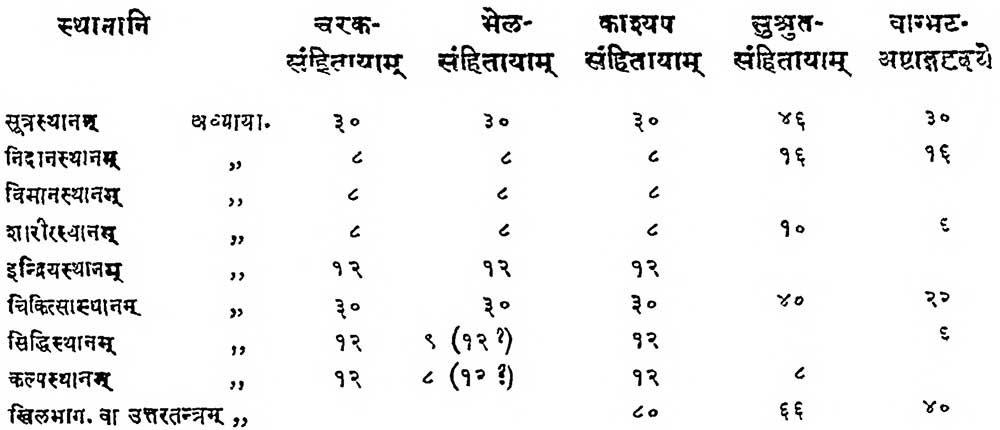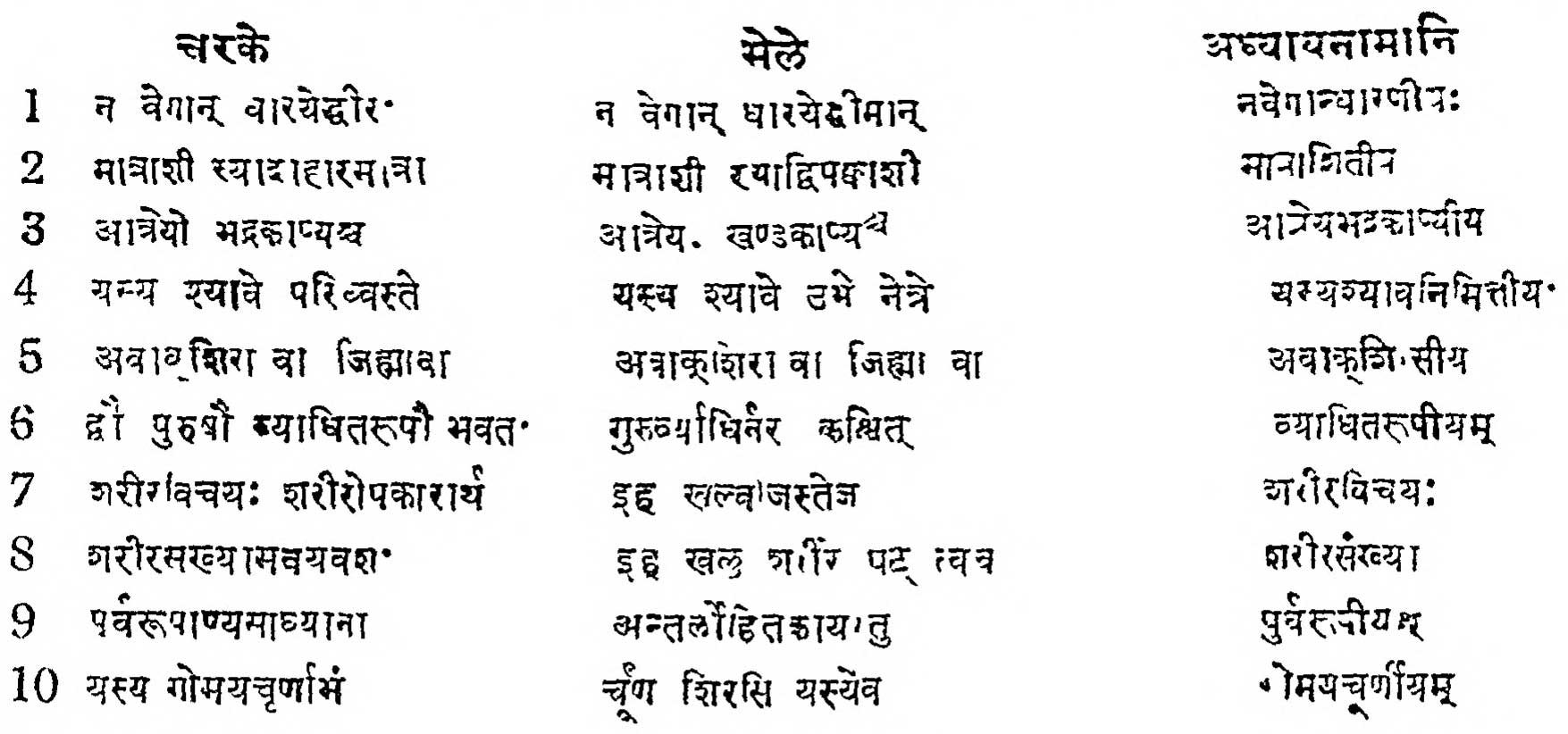History of Indian Medicine (and Ayurveda)
by Shree Gulabkunverba Ayurvedic Society | 1949 | 162,724 words | ISBN-13: 9788176370813
The History of Indian medicine and Ayurveda (i.e., the science of life) represents the introductory pages of the Charaka Samhita composed of six large sections dealing with every facet of Medicine in ancient India in a Socio-Historical context. Caraka is regarded as one of the pioneers in the field of scientific healthcare. As an important final a...
Chapter 8 - Caraka Samhita—A Redacted Treatise
We find that 79 chapters of Caraka Samhita end with the following sentence:—
[agniveśakṛte tantre carakapratisaṃskṛte]
These 79 chapters are distributed in the different sections as under:—
30 in the section on General Principles.
8 in the section on Pathology.
8 in the section on Specific Determination.
8 in the section on Human Embodiment.
12 in the section on Sensorial Prognosis.
13 in the section on Therapeutics.
But the remaining 41 chapters end with the following addition to the above quoted ending—[aprāpte dṛḍhabalapūrite] or [aprāpte dṛḍhabalasaṃpūrite].
These 41 chapters are distributed in the different sections as under—
17 in the section on Therapeutics.
12 in the section on Pharmaceutics
12 in the section on Success in Treatment.
Out of these, one chapter i.e. the 25th chapter in the section on Therapeutics ends as follows—
[agniveśakṛte tantre carakapratisaṃskṛte dṛḍhabalasaṃpūrite]
In this the word aprapte is not found. All this indicates that the text of the 79 chapters is the portion expounded by Agnivesha and redacted by Caraka, while the text of the remaining 41 chapters is the portion expounded by Agnivesa as restored by Dridhabala in the place of the unavailable portions of Caraka’s redaction.
According to the History of Ayurveda as found in the texts, we learn that Bhagavan Atreya expounded the whole science to six pupils. Each of them tried to write a systematic treatise according to his grasp and intelligence.
[Carakasaṃhitā Sūtrasthāna 33]
[?? aya bhelādayaścakru svaṃ sva tantraṃkṛtāni ca]
The treatise of Agnivesha was the outstanding one among these and it received the sanction and authorisation of the committee of learned sages Out of the six treatises of the pupils of Atreya, only two are at present available. One is the Agnivesha-tantra (Agniveśatantra) and the other Bhela-samhita (Bhelasaṃhitā). The latter is available only in fragments and hence it is incomplete. It is a very short and concise form though greatly similar to Agnivesha’s treatise in the treatment of subject, order of arrangement, classification etc, leading to the conclusion that both received their instruction from the same preceptor. The Agnivsha Samhita being the outstanding work out of all the six received the attention of the redactors who corporated into the body the progress achieved from time to time.
The period from Atreya to Dridhabala covers at least 1000 years. This was the golden period of Ayurveda and the science was continually progressive. This original text of Agnivesha might have been reviewed and redacted very often to assimilate the features of progressive science and to adapt it to the circumstances of the period, but only two redactions are known at present.
A vast field for research work lies unexplored in these treatises. The subject for research would be what actually was preached by Atreya, what was described by Agnivesha, what Caraka did while redacting it by way of alterations and additions what portion was modified or completed or reconstructed by Dridhbala, what were the other redactions, when were these redactions made etc. The research workers will have to resort to general history, records etc, but the labour will be amply repaid. When properly explored this quest should throw light not only on the history of medicine, but it would enlighten us on the general history of Aryan civilization from various points of view.
Now let us see what a redaction (pratisaṃskāra) is. Dridhabala gives the definition of redaction as follows:
[...]
“The redactor enlarges what is concise and abbreviates what is very prolix and in this manner brings an ancient work up-to-date”.
Redaction (saṃskaraṇa) is also defined as under:
[...]
“That is called redaction by which an author correlates and supplements a work by corresponding facts and statements found in other treatises specially bearing on a subject”.
Thus we see that in a redacted work the terse portions in the original treatise is made lucid by elaboration and the portion treated too prolificly is abridged.
There are two methods of redaction. One is technically known as Sangraha and Vigraha (saṃgraha-vigraha) method as defined by Dridhabala. The other is known as Avapodvapa (āvāpodvāpa) method. The latter changes the very construction and system of the whole work altogether, and makes radical alterations changing the mould of the work. Caraka seems to have followed the former method.
The Caraka Samhita only a modified form of the original
If we compare Caraka Samhita with Bhela Samhita we find striking similarities, all pointing to one common source.
1. The text is divided in eight Sthanas out of which Vimana (vimāna) Indriya and Sidhi are the new words with specific meanings used only in Caraka, Kashyapa and Bhela Samhitas and these new words are not found in Sushruta or later medical works. The word Kalpa is used in a somewhat different meaning than as used in Sushruta or later medical works.
2. The prevalent system in those days seems to be to have 120 chapters in all in medical text books. We find 120 chapters in Caraka, Bhela, Kasyapa, Sushruta and Vagbhata, the last named author makes 120 chapters with the addition of an extra section—Uttaratantra.
Thus, though the total number of 120 is maintained, the number of chapters in each section varies in Caraka Sushruta and Vaghbhata but it remains the same in Caraka, Bhela and Kashyapa:

3 The titles of chapters are very often the same in the Caraka and Bhela Samhitas.
Caraka adopts the following method of nomenclature of chapters—
- According to subject.
- According to the first word or phrase in the chapter.
A greater resemblance is found between the Caraka Samhita and Bhela Samhita as will be evident from the following examples.

In the above instances we find that the first five are quite similar in both Caraka and Bhela and naturally both have given the same titles to the chapters in their works. Though the first lines differ in a considerable degree yet we find that the titles of the chapters in both the works are the same
4. Besides this resemblance of titles, we come across many concepts and descriptions which are common to both Caraka and Bhela.
- tisraiṣaṇīya;
- guruvyādhi;
- sadyomaraṇa;
- atulyagotra;
- āhāramātrā (gurulaghava);
- catuṣpāda;
- daśadhamanī and hṛdaya;
- garbhotpatti and factors;
- the legend of Fever;
- saṃprāpti of śoṣa;
- upadhāpaddhati;
- Frightening or shock therapy in Insanity;
- Cobra venom in viśoṣajvara.
There is a school of thought which ascribes the entire work to Caraka. It says that it was only a vague nucleus in the form of common medical knowledge round which Caraka reconstructed a grand edifice But such a conclusion is precluded by the very text of the colophon [agniveśakṛte tantre carakapratisaṃskṛte]
Undoubtedly there is much that has been added, there is much that has been abridged or expanded. Yet that Caraka merely redacted the old work cannot be denied Caraka never claims the authorship for the work. Internal evidence also corroborates the same view point.
Even Dridhabala the restorer and redactor of the last portions based his work on the original treatise and Its parallel treatises.
[...]
“Thus this best of all treatises which is replete with truth and wisdom and which has been redacted by the extremely enlightened scholar Caraka is now available only in three quarters of the original extent... He in whose memory resides this compendium of these twelve thousand verses... (knows) the science of therapeutics, compiled by Agnivesha for the well being of the health) and the ailing”.
Thus he confirms that Agnivesha was the author of the treatise consisting of twelve thousand verses. The credit of the authorship and the popular title of ‘Caraka Samhita’ are probably due to the fact that Caraka in his missionary zeal for propagating this master piece of medical work, travelled extensively for research, lectures, propagation and experimentation and gained the nick name of Caraka—one who moves constantly. His name has got precedence over the original title of the work as Agnivesha-tantra, and the work has ever since been named after Caraka in the world.
Caraka’s contribution
That Caraka merely revised and redacted an old treatise does not detract from his greatness. The ingenious method of redaction he adopted, has lent a touch of freshness and originality and though Caraka is technically only a redactor, he must be given credit for modifying the old work and transforming it by his magic touch, into a work of unrivalled merits, which has stood the test of 2000 years.
Thus we see that Atreya Samhita (Ātreya Saṃhitā) was the seed which was watered by Agnivesha and nurtured by Caraka. It became the medical inheritance of the race, though it underwent changes, with the accretions of the thought and experience of the succeeding centuries. According to the definition of redaction (saṃskāra) given by Dridhabala the redaction adds much that is new and deletes much that is old Viewing the Caraka Samhita in the light of this definition, we find that Caraka has contributed much that is original.
1. The theory of Vada-nyaya (vādanyāya) found in Caraka Samhita belongs to that stage of thought development to which belonged Carakas.
2 In sudation chapter (svedādhyāya) Bhela Samhita enumerates only eight kinds (saṃkara[?], prastara, seka, etc) while Caraka adds five more bringing the total to thirteen. In Kashyapa Samhita also we find 8 kinds. This leads us to the conclusion that old works knew only eight kinds and that Caraka has contributed five kinds more. Palakapya in his Hasti Ayurveda refers to Agnivesha’s methods of sudation and there the additional kinds of sudation are mentioned. Thus those varieties described in Caraka Samhita are Caraka’s own contribution
3. The Bhela Samhita has only one chapter (“khuḍḍikāgarbhāvakānti[?]”) Caraka has also the same chapter propounding a similar theory But later on in Caraka we find a chapter (“mahāgarbhāvakānti[?]”) in which the subject treated shows an unmistakable flavour of later thought developments.
Thus Caraka, although he is a redactor only, there is much that he has added as his original contribution and it would indeed be a very interesting research work for scholars to find out what exactly his contribution was.
